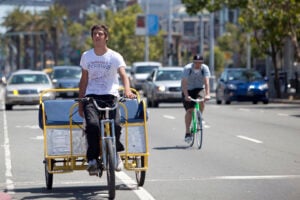
CITY HALL — In a town plagued by traffic, a new form of passenger vehicle will now be set to take to the roadways — the pedicab.
The City Council approved regulations for the human-powered taxis Tuesday night as a way to provide structure to what they described as the "wild west" that might otherwise reign on Santa Monica streets.
As approved, pedicab companies would be required to obtain a permit that defines where they will operate and how many pedicabs the company would put on the road. They could not use the Beach Bike Path.
Fares must be posted, and each of the pedicabs must have headlights, tail lights, turn signals, brakes, spoke reflectors and each of the passengers must be restrained by seat belts.
Regulations also apply to the drivers who must be at least 18 years old and free of drug, driving under the influence or sex offense convictions, have taken a bicycle safety training course and have a decent driving history through the Department of Motor Vehicles.
Pedicabs have proliferated in recent years in many waterfront cities, including San Francisco, San Diego and Long Beach.
San Francisco requires that pedicabs designate the routes they plan to use, stick to bicycle lanes rather than sidewalks and get permits, said Officer Al Steward of the San Francisco Police Department. The Municipal Transportation Authority has the power to sign off on specific routes after ensuring that they will not negatively impact traffic.
San Francisco also requires bike inspections roughly once a year, Steward said.
San Diego requires a specific kind of permit to operate in the most popular areas of the city, including the Gaslamp District and waterfront, according to that city's website. There are only a limited number of those permits, although permits for other areas do not have that restriction.
Officials are not suggesting a franchise system like that which applies to taxi cabs in the city, nor do the regulations put a cap on the number of pedicabs or the rates they charge, said Salvador Valles, business and operations manager with the city's Finance Department.
"Should we need to confront this issue, the city will exercise all legal options available to address any circulation or public safety issues created by pedicabs operating on public streets, including working with our state legislators to clarify such authority," Valles said Thursday.
Instead, City Hall plans to charge fees for operator permits, decal permits and driver's permits — which are expected to bring in $2,950 in the 2013-14 fiscal year — and ramp up regulations if necessary.
Those fees only cover administrative time rather than any kind of enforcement costs, which would be handled by the police department similar to any other traffic issue.
The issue arose in June 2012 when a pedicab business called Trike Pilots, Inc. applied for a business license to operate 20 pedicabs from the Main Street district to the Montana Avenue district.
At the time, City Hall had no existing rules about how such a business might operate, and officials organized a study session with the City Council in October of that year.
Council members, and a handful of residents who spoke, expressed concern about the impact that the pedicabs might have on traffic and congestion in the popular downtown area.
"I don't know what we do if this gets out of hand and we create traffic jams that we can't control," said Councilmember Bob Holbrook. "I'm concerned that we're going to get so many of them that they become a scourge."
As it stands, City Hall does not have the ability to keep pedicabs off the streets because they operate under the same rules as regular bicycles and there's no basis to deny a business license.
In Councilmember Kevin McKeown's mind, that made whatever the council could do on Tuesday better than the status quo.
"Absent this ordinance, you're saying that they can operate without restriction," McKeown said. "Concerns that people have about whether or not this is a good idea should be about whether or not we impose some kind of control."
Others chose to highlight the positive aspects of the regulation, specifically giving Santa Monicans and tourists alike an even more environmentally-friendly option for traversing the city.
It might even be easier to get a ride home from a pedicab than a normal taxi because regular taxis avoid short fares, said Councilmember Gleam Davis.
She requested a status report on the program within six months.
Even the limited regulations may have unintended consequences.
Jay Miller and Frank Congine are part of the Beach Barcycle team, a unique contraption that allows up to 16 passengers to pedal under the guidance of a licensed driver from bar to bar along Main Street and other areas of the city.
They received a notice that the Barcycle would be considered a pedicab under the proposed law because it carries passenger for hire.
The Barcycle should be in a separate category, because the business model is very different than that of the pedicab, Miller said.
It must be rented out weeks in advance, doesn't pick up random passengers along the route and comes at a set fee for a specific number of hours, unlike a pedicab that is searching for fares.
The Barcycle worked with City Hall for a year to get its business license because the concept was so new to the area, Congine said.
"We don't want to be grouped in because the business operates so differently," Congine said. "We wouldn't want to be lumped in with someone else who came up in the next few months and had an issue."
ashley@www.smdp.com









